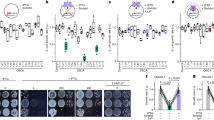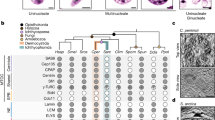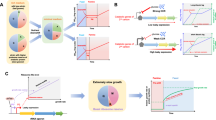Abstract
THE oriented movement of unicellular algae, such as Chlamydomonas, is usually regarded as being either positive or negative, when evoked by light of a fixed intensity. Until recently it has been difficult to measure phototactic responses of algae quantitatively and rapidly, but methods have now been described for following the phototactic response of a population of algae1,2. These methods are based on a photoelectric monitoring of the distribution of the algae in a suspension, during exposure to light which evokes oriented response. We have adopted the method of Feinleib and Curry2 essentially unmodified to follow the initial response of cultures of Chlamydomonas reinhardii (WT + 2). The experiments were undertaken to study the variability of the phototactic response of cultures of Chlamydomonas which we previously observed3,4. We will show that the same culture of Chlamydomonas can be negative or positive in its response to a given fixed intensity of orienting light. The organism seems to adapt rapidly to conditions prevailing before measurement. Cultures were grown as described before3,4 in continuous light in an inorganic medium2, with constant stirring by a magnetic stirrer. The phototactic response of the cultures immediately after the orienting light was switched on was observed. Cultures frequently did not respond in a clear cut manner; a slight positive response was often followed by a negative one. If cultures were exposed to light in the apparatus for increasing periods of the time and their phototactic responses were measured periodically, the initial positive response increased and the subsequent negative one decreased (Fig. 1). These results indicated that the cells were adapting to the light so that their phototactic response changed. The following experiment was therefore undertaken. A culture was selected the initial response of which was negative. This culture was now illuminated for 2 h with 200 ft.-candles light from an incandescent lamp and its response again measured. The culture which had shown a strong and immediate negative response now responded positively to the same light intensity. The culture was now returned to darkness for 75 min and its response was measured again. As Fig. 2 shows, it now responded negatively.
This is a preview of subscription content, access via your institution
Access options
Subscribe to this journal
Receive 51 print issues and online access
$199.00 per year
only $3.90 per issue
Buy this article
- Purchase on Springer Link
- Instant access to full article PDF
Prices may be subject to local taxes which are calculated during checkout
Similar content being viewed by others
References
Lindes, D., Diehn, B., and Tollin, G., Rev. Sci. Instrum., 36, 1721 (1963).
Feinleib, M. E. H., and Curry, G. M., Physiol. Plant., 20, 1683 (1967).
Stahl, N., and Mayer, A. M., Science, 141, 1282 (1963).
Chorin-Kirsch, I., and Mayer, A. M., Nature, 203, 1085 (1964).
Soeder, C. J., Umschau in Wissenschaft und Technik, 67, 388 (1967).
Author information
Authors and Affiliations
Rights and permissions
About this article
Cite this article
MAYER, A. Chlamydomonas: Adaptation Phenomena in Phototaxis. Nature 217, 875–876 (1968). https://doi.org/10.1038/217875b0
Received:
Issue Date:
DOI: https://doi.org/10.1038/217875b0
This article is cited by
-
Abscisic acid induced a negative geotropic response in dark-incubated Chlamydomonas reinhardtii
Scientific Reports (2019)
-
Phototaxis beyond turning: persistent accumulation and response acclimation of the microalga Chlamydomonas reinhardtii
Scientific Reports (2017)
-
Photosensory transduction in the flagellated alga, Euglena gracilis
Archives of Microbiology (1983)
-
Phototaktische Untersuchungen an Chlamydomonas reinhardii Dangeard in homokontinuierlicher Kultur
Archiv f�r Mikrobiologie (1971)
Comments
By submitting a comment you agree to abide by our Terms and Community Guidelines. If you find something abusive or that does not comply with our terms or guidelines please flag it as inappropriate.



